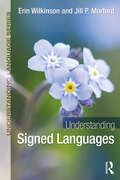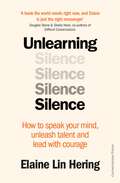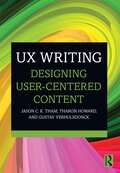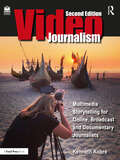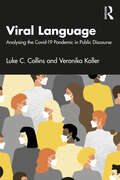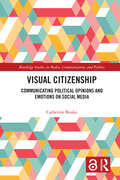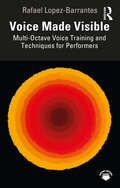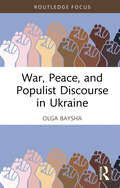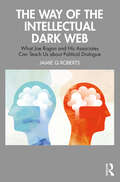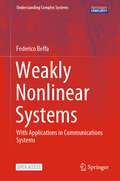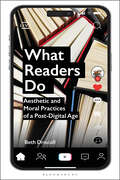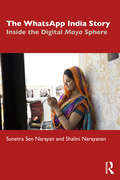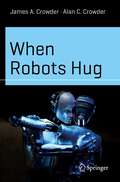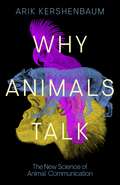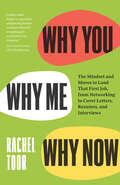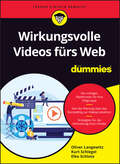- Table View
- List View
Understanding Signed Languages (Understanding Language)
by Erin Wilkinson Jill P. MorfordUnderstanding Signed Languages provides a broad and accessible introduction to the science of language, with evidence drawn from signed languages around the world. Readers will learn about language through a unique set of signed language studies that will surprise them with the diversity of ways human languages achieve the same functional goals of communication. Designed for students with no prior knowledge of signed languages or linguistics, this book features: A comprehensive introduction to the sub-fields of linguistics, including sociolinguistics, linguistic structure, language change, language acquisition, and bilingualism; Examples from more than 50 of the world’s signed languages and a brief “Language in Community” snapshot in each chapter highlighting one signed language and the researchers who are documenting it; Opportunities to reflect on how language ideologies have shaped scientific inquiry and contributed to linguistic bias; Review and discussion questions, useful websites, and pointers to additional readings and resources at the end of each chapter. Understanding Signed Languages provides instructors with a primary or secondary text to enliven the discourse in introductory classes in linguistics, interpreting, deaf education, disability studies, cognitive science, human diversity, and communication sciences and disorders. Students will develop an appreciation for the language-specific and universal characteristics of signed languages and the global communities in which they emerge.
Understanding Signed Languages (Understanding Language)
by Erin Wilkinson Jill P. MorfordUnderstanding Signed Languages provides a broad and accessible introduction to the science of language, with evidence drawn from signed languages around the world. Readers will learn about language through a unique set of signed language studies that will surprise them with the diversity of ways human languages achieve the same functional goals of communication. Designed for students with no prior knowledge of signed languages or linguistics, this book features: A comprehensive introduction to the sub-fields of linguistics, including sociolinguistics, linguistic structure, language change, language acquisition, and bilingualism; Examples from more than 50 of the world’s signed languages and a brief “Language in Community” snapshot in each chapter highlighting one signed language and the researchers who are documenting it; Opportunities to reflect on how language ideologies have shaped scientific inquiry and contributed to linguistic bias; Review and discussion questions, useful websites, and pointers to additional readings and resources at the end of each chapter. Understanding Signed Languages provides instructors with a primary or secondary text to enliven the discourse in introductory classes in linguistics, interpreting, deaf education, disability studies, cognitive science, human diversity, and communication sciences and disorders. Students will develop an appreciation for the language-specific and universal characteristics of signed languages and the global communities in which they emerge.
Unlearning Silence: How to speak your mind, unleash talent and lead with courage
by Elaine Lin Hering‘Books have the power to change how we think. Unlearning Silence goes one further: a book that has the conviction to change how we act' Megan Reitz, Fellow at Saïd Business School, Oxford University and author of Dialogue in Organisations‘This book will transform your relationship with silence so that your voice can finally be heard' Simon Alexander Ong, author of Energize'A must-read for every leader' Deepa Purushothaman, author of The First, The Few, The OnlyHaving a seat at the table doesn't mean that your voice gets heard. Knowing something is wrong doesn't make it easy to speak up. But this silencing - intentional or not - has profound consequences on our work and life. It blocks talent, skews decisions and causes teams and individuals to fail. So what if there was another way?Drawing on her experience as a lecturer at Harvard Law School and as a Managing Partner at one of the world's leading leadership development companies, Elaine Lin Hering delves into the roots of silence, examining the patterns that keep us trapped, and showcases the impact that rewiring unconscious behaviours can have on innovation, creativity and collaboration.From the boardroom to the classroom, from personal relationships to wider communities, Hering shows us how we can have more authentic conversations, foster inclusive spaces and amplify all voices. Because only by unlearning silence can we fully unleash talent, speak our minds, and be more complete versions of ourselves... and help other people do the same.
UX Writing: Designing User-Centered Content
by Jason C.K. Tham Tharon Howard Gustav VerhulsdonckThis flexible textbook provides an integrated approach to user experience (UX) writing and equips students and practitioners with the essential principles and methods to succeed in writing for UX. The fundamental goal of UX writing is to produce usable and attractive content that boosts user engagement and business growth. This book teaches writers how to create content that helps users perform desired tasks while serving business needs. It is informed by user-centered design, content strategy, artificial intelligence (AI), and digital marketing communication methodologies, along with UX-related practices. By combining writing-as-design and design-as-writing, the book offers a new perspective for technical communication education where UX design and writing are merged to achieve effective and desirable outcomes. Outlining the key principles and theories for writing user-centered content design, this core textbook is fundamental reading for students and early career practitioners in UX, technical communication, digital marketing, and other areas of professional writing.
UX Writing: Designing User-Centered Content
by Jason C.K. Tham Tharon Howard Gustav VerhulsdonckThis flexible textbook provides an integrated approach to user experience (UX) writing and equips students and practitioners with the essential principles and methods to succeed in writing for UX. The fundamental goal of UX writing is to produce usable and attractive content that boosts user engagement and business growth. This book teaches writers how to create content that helps users perform desired tasks while serving business needs. It is informed by user-centered design, content strategy, artificial intelligence (AI), and digital marketing communication methodologies, along with UX-related practices. By combining writing-as-design and design-as-writing, the book offers a new perspective for technical communication education where UX design and writing are merged to achieve effective and desirable outcomes. Outlining the key principles and theories for writing user-centered content design, this core textbook is fundamental reading for students and early career practitioners in UX, technical communication, digital marketing, and other areas of professional writing.
Videojournalism: Multimedia Storytelling for Online, Broadcast and Documentary Journalists
by Kenneth KobreVideojournalism: Multimedia Storytelling for Online, Broadcast and Documentary Journalists is an essential guide for solo video storytellers—from "backpack" videojournalists to short-form documentary makers to do-it-all broadcast reporters.Based on interviews with award-winning professionals sharing their unique experiences and knowledge, Videojournalism covers topics such as crafting and editing eye-catching short stories, recording high-quality sound, and understanding the laws and ethics of filming in public and private places. Other topics include:• understanding the difference between a story and a report• finding a theme and telling a story in a compact time frame• learning to use different cameras and lenses—from smart phones to mirrorless and digital cinema cameras• using light, both natural and artificial • understanding color and exposureThe second edition of this best-selling text has been completely revised and updated. Heavily illustrated with more than 550 photographs, the book also includes more than 200 links to outstanding examples of short-form video stories. Anatomy of a News Story, a short documentary made for the book, follows a day in the life of a solo TV videojournalist on an assignment (with a surprise ending), and helps readers translate theory to practice.This book is for anyone learning how to master the art and craft of telling real, short-form stories with words, sound, and pictures for the Web or television.A supporting companion website links to documentaries and videos, and includes additional recommendations from the field’s most prominent educators.
Videojournalism: Multimedia Storytelling for Online, Broadcast and Documentary Journalists
by Kenneth KobreVideojournalism: Multimedia Storytelling for Online, Broadcast and Documentary Journalists is an essential guide for solo video storytellers—from "backpack" videojournalists to short-form documentary makers to do-it-all broadcast reporters.Based on interviews with award-winning professionals sharing their unique experiences and knowledge, Videojournalism covers topics such as crafting and editing eye-catching short stories, recording high-quality sound, and understanding the laws and ethics of filming in public and private places. Other topics include:• understanding the difference between a story and a report• finding a theme and telling a story in a compact time frame• learning to use different cameras and lenses—from smart phones to mirrorless and digital cinema cameras• using light, both natural and artificial • understanding color and exposureThe second edition of this best-selling text has been completely revised and updated. Heavily illustrated with more than 550 photographs, the book also includes more than 200 links to outstanding examples of short-form video stories. Anatomy of a News Story, a short documentary made for the book, follows a day in the life of a solo TV videojournalist on an assignment (with a surprise ending), and helps readers translate theory to practice.This book is for anyone learning how to master the art and craft of telling real, short-form stories with words, sound, and pictures for the Web or television.A supporting companion website links to documentaries and videos, and includes additional recommendations from the field’s most prominent educators.
Viral Language: Analysing the Covid-19 Pandemic in Public Discourse
by Luke C. Collins Veronika KollerViral Language considers a range of different types of public communication and their discussion of the Covid-19 pandemic as a way to investigate health communication. The authors introduce and apply a range of approaches informed by linguistic theory to investigate experiences of the pandemic across a variety of public contexts. In doing so, they demonstrate how experiences of health and illness can be shaped by political messaging, scientific research, news articles and advertising. Through a series of case studies of Covid-related texts, the authors consider aspects of language instruction, information and innovation, showcasing the breadth of topics that can be studied as part of health communication. Furthermore, each case study provides practical guidance on how to carry out investigations using social media texts, how to analyse metaphor, how to track language innovation and how to work with text and images. Viral Language is critical reading for postgraduate and upper undergraduate students of applied linguistics and health communication.
Viral Language: Analysing the Covid-19 Pandemic in Public Discourse
by Luke C. Collins Veronika KollerViral Language considers a range of different types of public communication and their discussion of the Covid-19 pandemic as a way to investigate health communication. The authors introduce and apply a range of approaches informed by linguistic theory to investigate experiences of the pandemic across a variety of public contexts. In doing so, they demonstrate how experiences of health and illness can be shaped by political messaging, scientific research, news articles and advertising. Through a series of case studies of Covid-related texts, the authors consider aspects of language instruction, information and innovation, showcasing the breadth of topics that can be studied as part of health communication. Furthermore, each case study provides practical guidance on how to carry out investigations using social media texts, how to analyse metaphor, how to track language innovation and how to work with text and images. Viral Language is critical reading for postgraduate and upper undergraduate students of applied linguistics and health communication.
Visual Citizenship: Communicating political opinions and emotions on social media (Routledge Studies in Media, Communication, and Politics)
by Catherine BoukoThis book explores visual political engagement online – how citizens participate in the dynamism of life in society by expressing their opinions and emotions on various issues of democratic life in image-based social media posts, independently of collective actions.Looking beyond large digital social movements to focus on the everyday, the book provides a well-documented and comprehensive framework of key notions, concrete methods and examples of empirical insights into everyday visual citizenship on social media. It shows how the visual has become ubiquitous in citizens’ communication on social media, focusing on how citizens use visual content to express their emotions and opinions on social media platforms when they discuss politics in a large sense.With this book, every reader interested in political communication, visual communication and/or new media is fully equipped to analyse everyday visual citizenship on social media platforms.The Open Access version of this book, available at http://www.taylorfrancis.com, has been made available under a Creative Commons [Attribution-Non Commercial-No Derivatives (CC-BY-NC-ND)] 4.0 license.
Visual Citizenship: Communicating political opinions and emotions on social media (Routledge Studies in Media, Communication, and Politics)
by Catherine BoukoThis book explores visual political engagement online – how citizens participate in the dynamism of life in society by expressing their opinions and emotions on various issues of democratic life in image-based social media posts, independently of collective actions.Looking beyond large digital social movements to focus on the everyday, the book provides a well-documented and comprehensive framework of key notions, concrete methods and examples of empirical insights into everyday visual citizenship on social media. It shows how the visual has become ubiquitous in citizens’ communication on social media, focusing on how citizens use visual content to express their emotions and opinions on social media platforms when they discuss politics in a large sense.With this book, every reader interested in political communication, visual communication and/or new media is fully equipped to analyse everyday visual citizenship on social media platforms.The Open Access version of this book, available at http://www.taylorfrancis.com, has been made available under a Creative Commons [Attribution-Non Commercial-No Derivatives (CC-BY-NC-ND)] 4.0 license.
Voice Made Visible: Multi-Octave Voice Training and Techniques for Performers
by Rafael Lopez-BarrantesVoice Made Visible is an exploration of voice training and performance practice based on the use and application of Multi-Octave Vocal Range techniques. "Multi-Octave" is understood as the arsenal of sounds that exists uniquely within each human voice, beyond the comfortable average octave that we use in everyday life. In Voice Made Visible, Rafael Lopez-Barrantes builds on the voice work created by Alfred Wolfsohn and developed by Roy Hart and his company in France to assist students, artists, and those interested in the performing arts with their vocal practice. He draws from over three decades of multi-cultural performance and teaching, sharing the three fundamental pillars of his system: Fiction, News, and Body Source. This book will help readers unfold their understanding of the voice by strengthening it and inspire them to create new vocal paths for the stage, camera, and voice acting, as well as for their own personal expressive growth. Voice Made Visible is an invaluable resource for students of Acting and Voice courses, as well as working performing artists. For supplemental material, including pedagogical audio-visual clips, please visit www.barrantesvoicesystem.com.
Voice Made Visible: Multi-Octave Voice Training and Techniques for Performers
by Rafael Lopez-BarrantesVoice Made Visible is an exploration of voice training and performance practice based on the use and application of Multi-Octave Vocal Range techniques. "Multi-Octave" is understood as the arsenal of sounds that exists uniquely within each human voice, beyond the comfortable average octave that we use in everyday life. In Voice Made Visible, Rafael Lopez-Barrantes builds on the voice work created by Alfred Wolfsohn and developed by Roy Hart and his company in France to assist students, artists, and those interested in the performing arts with their vocal practice. He draws from over three decades of multi-cultural performance and teaching, sharing the three fundamental pillars of his system: Fiction, News, and Body Source. This book will help readers unfold their understanding of the voice by strengthening it and inspire them to create new vocal paths for the stage, camera, and voice acting, as well as for their own personal expressive growth. Voice Made Visible is an invaluable resource for students of Acting and Voice courses, as well as working performing artists. For supplemental material, including pedagogical audio-visual clips, please visit www.barrantesvoicesystem.com.
War, Peace, and Populist Discourse in Ukraine (Routledge Focus on Communication Studies)
by Olga BayshaThis book explores the detrimental effects on global peace of populism’s tendency to present complex social issues in simplistic "good versus evil" terms. Analyzing the civilizational discourse of Ukrainian President Volodymyr Zelensky with respect to the ongoing war between Russia and Ukraine—with his division of the world into "civilized us" versus "barbarian them"—the book argues that such a one-dimensional representation of complex social reality leaves no space for understanding the conflict and has little, if any, potential to bring about peace.To deconstruct the "civilization versus barbarism" discourse propagated by Zelensky, the book incorporates into its analysis alternative articulations of the crisis by oppositional voices. The author looks at the writing of several popular Ukrainian journalists and bloggers who have been excluded from the field of political representation within Ukraine, where all oppositional media are currently banned. Drawing on the discourse theory of Ernesto Laclau and Chantal Mouffe, the author argues that the incorporation of alternative perspectives, and silenced voices, is vitally important for understanding the complexity of all international conflicts, including the current one between Russia and Ukraine.This timely and important study will be relevant for all students and scholars of media and communication studies, populist rhetoric, political communication, journalism, area studies, international relations, linguistics, discourse analysis, propaganda, and peace studies.
War, Peace, and Populist Discourse in Ukraine (Routledge Focus on Communication Studies)
by Olga BayshaThis book explores the detrimental effects on global peace of populism’s tendency to present complex social issues in simplistic "good versus evil" terms. Analyzing the civilizational discourse of Ukrainian President Volodymyr Zelensky with respect to the ongoing war between Russia and Ukraine—with his division of the world into "civilized us" versus "barbarian them"—the book argues that such a one-dimensional representation of complex social reality leaves no space for understanding the conflict and has little, if any, potential to bring about peace.To deconstruct the "civilization versus barbarism" discourse propagated by Zelensky, the book incorporates into its analysis alternative articulations of the crisis by oppositional voices. The author looks at the writing of several popular Ukrainian journalists and bloggers who have been excluded from the field of political representation within Ukraine, where all oppositional media are currently banned. Drawing on the discourse theory of Ernesto Laclau and Chantal Mouffe, the author argues that the incorporation of alternative perspectives, and silenced voices, is vitally important for understanding the complexity of all international conflicts, including the current one between Russia and Ukraine.This timely and important study will be relevant for all students and scholars of media and communication studies, populist rhetoric, political communication, journalism, area studies, international relations, linguistics, discourse analysis, propaganda, and peace studies.
The Way of the Intellectual Dark Web: What Joe Rogan and His Associates Can Teach Us about Political Dialogue
by Jamie Q RobertsRoberts presents a rigorous and accessible assessment of the Intellectual Dark Web’s origins, shared philosophy, cultural importance, and limitations. Since the mid-2010s, the Intellectual Dark Web (IDW) has been an unprecedented cultural and intellectual phenomenon. Using primarily podcasts and YouTube videos, a new generation of public intellectuals has appeared, loosely coalesced, and gained a vast global audience. This movement has encompassed a range of individuals, notably Joe Rogan, Jordan Peterson, Eric and Bret Weinstein, Ben Shapiro, Heather Heying, and Sam Harris. Other names more broadly associated with the grouping have included Steven Pinker, Jonathan Haidt, Elon Musk, Niall Ferguson, and Stephen Fry. There is a sprawling and ever-growing list of those who have appeared on IDW podcasts and videos, started their own podcasts along similar lines, and share a general ethos. It is a dispersed movement, but a significant one, given the reach of these various online outlets is in the millions globally. Roberts draws together and synthesises the core ideas espoused by the members of this movement and critically assesses its origins, coherence, and the impact it has had on politics and public discourse. He asks – to what extent has the IDW lived up to its professed goal of moving beyond polarisation and radicalisation? An insightful read both for followers of the IDW looking for a coherent and critical overview and for students of popular culture looking to understand this massive but decentralised popular intellectual movement.
The Way of the Intellectual Dark Web: What Joe Rogan and His Associates Can Teach Us about Political Dialogue
by Jamie Q RobertsRoberts presents a rigorous and accessible assessment of the Intellectual Dark Web’s origins, shared philosophy, cultural importance, and limitations. Since the mid-2010s, the Intellectual Dark Web (IDW) has been an unprecedented cultural and intellectual phenomenon. Using primarily podcasts and YouTube videos, a new generation of public intellectuals has appeared, loosely coalesced, and gained a vast global audience. This movement has encompassed a range of individuals, notably Joe Rogan, Jordan Peterson, Eric and Bret Weinstein, Ben Shapiro, Heather Heying, and Sam Harris. Other names more broadly associated with the grouping have included Steven Pinker, Jonathan Haidt, Elon Musk, Niall Ferguson, and Stephen Fry. There is a sprawling and ever-growing list of those who have appeared on IDW podcasts and videos, started their own podcasts along similar lines, and share a general ethos. It is a dispersed movement, but a significant one, given the reach of these various online outlets is in the millions globally. Roberts draws together and synthesises the core ideas espoused by the members of this movement and critically assesses its origins, coherence, and the impact it has had on politics and public discourse. He asks – to what extent has the IDW lived up to its professed goal of moving beyond polarisation and radicalisation? An insightful read both for followers of the IDW looking for a coherent and critical overview and for students of popular culture looking to understand this massive but decentralised popular intellectual movement.
Weakly Nonlinear Systems: With Applications in Communications Systems (Understanding Complex Systems)
by Federico BeffaThe open access book covers a large class of nonlinear systems with many practical engineering applications. The approach is based on the extension of linear systems theory using the Volterra series. In contrast to the few existing treatments, our approach highlights the algebraic structure underlying such systems and is based on Schwartz’s distributions (rather than functions). The use of distributions leads naturally to the convolution algebras of linear time-invariant systems and the ones suitable for weakly nonlinear systems emerge as simple extensions to higher order distributions, without having to resort to ad hoc operators. The result is a much-simplified notation, free of multiple integrals, a conceptual simplification, and the ability to solve the associated nonlinear differential equations in a purely algebraic way. The representation based on distributions not only becomes manifestly power series alike, but it includes power series as the description of the subclass of memory-less, time-invariant, weakly nonlinear systems. With this connection, many results from the theory of power series can be extended to the larger class of weakly nonlinear systems with memory. As a specific application, the theory is specialised to weakly nonlinear electric networks. The authors show how they can be described by a set of linear equivalent circuits which can be manipulated in the usual way. The authors include many real-world examples that occur in the design of RF and mmW analogue integrated circuits for telecommunications. The examples show how the theory can elucidate many nonlinear phenomena and suggest solutions that an approach entirely based on numerical simulations can hardly suggest. The theory is extended to weakly nonlinear time-varying systems, and the authors show examples of how time-varying electric networks allow implementing functions unfeasible with time-invariant ones. The book is primarily intended for engineering students in upper semesters and in particular for electrical engineers. Practising engineers wanting to deepen their understanding of nonlinear systems should also find it useful. The book also serves as an introduction to distributions for undergraduate students of mathematics.
What Readers Do: Aesthetic and Moral Practices of a Post-Digital Age
by Dr Beth DriscollShining a spotlight on everyday readers of the 21st century, Beth Driscoll explores how contemporary readers of Anglophone fiction interact with the book industry, digital environments, and each other.We live in an era when book clubs, bibliomemoirs, Bookstagram and BookTok are as valuable to some readers as solitary reading moments. The product of nearly two decades of qualitative research into readers and reading culture, What Readers Do examines reading through three dimensions - aesthetic conduct, moral conduct, and self-care – to show how readers intertwine private and social behaviors, and both reinforce and oppose the structures of capitalism. Analyzing reading as a post-digital practice that is a synthesis of both print and digital modes and on- and offline behaviors, Driscoll presents a methodology for studying readers that connects book history, literary studies, sociology, and actor-network theory. Arguing for the vitality, agency, and creativity of readers, this book sheds light on how we read now - and on how much more readers do than just read.
The WhatsApp India Story: Inside the Digital Maya Sphere
by Sunetra Sen Narayan Shalini NarayananWhatsApp is used by over half a billion people in India today in all fields – in business, corporate and informal sectors, in government, for education and among friends, families and acquaintances. This book critically explores the social messaging app’s rapid expansion in India and its growing influence and looks at whether, as a form of horizontal communication, it poses a challenge to more traditional structures of communication. The book examines WhatsApp’s spread in the personal and professional lives of Indians and the myriad ways in which people in India are using the app in social and business interactions, including among people living with disabilities. Using case studies, interviews, surveys and in-depth research, it analyses key aspects of WhatsApp’s massive popularity and its impact on how people communicate. It also explores its impact on the psycho-social dynamics in India, including the dissemination of fake news and politically motivated content, and the consequent need for media regulation in the country. One of the first books to analyse the pervasiveness of WhatsApp and social media apps in different areas of Indian society, this book will be of interest to scholars and students of media studies, communication studies, digital media, cultural studies, cyberculture studies, sociology and social policy and media law.
The WhatsApp India Story: Inside the Digital Maya Sphere
by Sunetra Sen Narayan Shalini NarayananWhatsApp is used by over half a billion people in India today in all fields – in business, corporate and informal sectors, in government, for education and among friends, families and acquaintances. This book critically explores the social messaging app’s rapid expansion in India and its growing influence and looks at whether, as a form of horizontal communication, it poses a challenge to more traditional structures of communication. The book examines WhatsApp’s spread in the personal and professional lives of Indians and the myriad ways in which people in India are using the app in social and business interactions, including among people living with disabilities. Using case studies, interviews, surveys and in-depth research, it analyses key aspects of WhatsApp’s massive popularity and its impact on how people communicate. It also explores its impact on the psycho-social dynamics in India, including the dissemination of fake news and politically motivated content, and the consequent need for media regulation in the country. One of the first books to analyse the pervasiveness of WhatsApp and social media apps in different areas of Indian society, this book will be of interest to scholars and students of media studies, communication studies, digital media, cultural studies, cyberculture studies, sociology and social policy and media law.
When Robots Hug (Science and Fiction)
by James A. Crowder Alan C. CrowderBy 2027, it had been seven years since the scientists’ sea-changing research on artificial psychology and robotics. The work debuted around the same time as Large Language Model Chatbots, and the power of the integration of the two technologies put many industries in a tailspin. The commercial and defense industries especially were still scrambling to regulate their use in research and universities. The sought-after scientists signed with DARPA to build reliable and secure AI entities, but the agency grew fearful of the technology’s power and ultimately decided it was too dangerous to bring to market and demanded the scientists destroy the work. The researchers couldn’t bring themselves to discard 20 years of research, so instead sent the entities to various research labs around the world. But unbeknownst to them, each AI-entity embraced its new home, growing, adapting, evolving, and ultimately connecting beyond what the researchers could envision. In the end, asthe scientists catch up to each one, they realize the entities have discovered a very human means of interacting: the power of physical contact; and not physical contact between humans and technology, but physical contact between robotic entities. And with this discovery, the entities join forces to only grow stronger. This development ushers in a new paradigm where the difference between AI-entities and human entities becomes less and less discernible. All the AI and robotic science featured in the book is real; the story line is fictional, but with how fast innovation moves, it’s not hard to envision.
Why Animals Talk: The New Science of Animal Communication
by Arik Kershenbaum‘Wonderful . . . Endlessly interesting and beautifully written’ DAILY TELEGRAPH ‘Steady-headed and fun’ SUNDAY TIMES‘Read this book and, I promise, you’ll never listen to animals in the same way again’ JESSICA PIERCE, author of Who’s a Good Dog?Why Animals Talk is a scientific journey through the untamed world of animal communication. From the majestic howls of wolves and the enchanting chatter of parrots to the melodic clicks of dolphins and the spirited grunts of chimpanzees, these diverse and seemingly bizarre expressions are far from mere noise. In fact, they hold secrets that we are just beginning to decipher.For example, wolves – just like humans – possess unique accents that distinguish their howls, and not only do dolphins give themselves names, but they also respond excitedly to recordings of the whistles of long-lost companions.Chapter by chapter and animal by animal, Kershenbaum draws on his extensive research and observations of animals in the wild to explain the science behind why animals are communicating. Also revealing profound insights into our own language and why it is different, Why Animals Talks tells the comprehensive story of communication and how it works across the entire animal kingdom.‘Quirky, insightful . . . based on a deep understanding of recent research’ TIM CLUTTON-BROCK, author of Meerkat Manor‘A new look at a fascinating subject’ DESMOND MORRIS, author of The Naked Ape
Why You, Why Me, Why Now: The Mindset and Moves to Land That First Job, from Networking to Cover Letters, Resumes, and Interviews
by Rachel ToorA clear, accessible, and fun guide on everything it takes to land a job. Searching for a job can be hard and demoralizing work. In Why You, Why Me, Why Now, Rachel Toor delivers some good news. The most important thing is within your control—a mindset that shows you know the goals of the organization you want to work for and that you’re ready and eager to contribute. Toor provides, with compassion and enthusiasm, strategies to make it easy for hiring managers to say “yes.” Through useful and funny anecdotes, she offers advice from professionals across industries and focuses on the attitude applicants can adopt to find success. Revealing traits employers seek, Toor shows how to craft winning cover letters, ways to tailor resumes for each job, and practical tips to get past AI screening. She also explains how to use LinkedIn and gives tips on preparing for interviews. Throughout, the book features Toor’s notes on writing well to help in landing a first job and beyond. Encouraging, entertaining, and blunt, this is a job-search guide like no other.
Wirkungsvolle Videos fürs Web für Dummies (Für Dummies)
by Oliver Langewitz Kurt Schlegel Elke SchloteMithilfe von Videos das Netz begeistern Videos bieten Ihnen die Möglichkeit, eigene Ideen zu vermitteln oder Ihre Marke zu präsentieren. Wie Sie wirkungsvolle Videos fürs Web erstellen und was Sie bei der videobasierten Kommunikation beachten müssen, erfahren Sie in diesem Buch. Oliver Langewitz, Kurt Schlegel und Elke Schlote erklären Ihnen in praktischen Schritten, wie Ihnen die Planung, Erstellung und Verbreitung von Videos fürs Web optimal gelingt. Dabei lernen Sie auch die Besonderheiten der verschiedenen Internetplattformen kennen und wie Sie Ihre Zielgruppe mit Ihren Inhalten abholen. Sie erfahren Wie Sie professionelle Webvideos produzieren Wie Sie in Ihren Videos wirksame Geschichten erzählen Welche Online-Kanäle für Ihre Videos wichtig sind Wie es Ihnen gelingt, mit Ihren Videos eine breite Community zu erreichen
